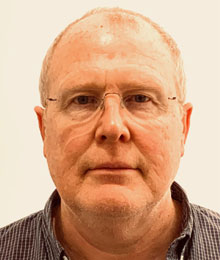An interview with David Edwards
David Edwards is a Senior Lecturer at the University of Dundee UK. He is also a member of the Microbiology Society, and in this interview, he tells us more about his research into SARS-CoV-2.

Tell us more about your research.
My current project aims to investigate oral cell lines to establish which ones are particularly sensitive to SARS-CoV-2 infection, with the ultimate aim of developing a platform to screen for small molecules that can reduce viral entry. At the beginning of our work the expression of the key viral receptor ACE2 in tongue tissue had been noted using publicly available RNA sequenced data, and the loss of taste (dysgeusia) was being reported as a potential diagnostic tool. Consequently, we assembled taste bud, tongue, and salivary gland cell lines to look at expression of key markers under laboratory conditions. Since 108 viral particles per ml have been detected in saliva, we considered it worth understanding better the oral cavity as both a source of virions and a site of infection.
What inspired this research?
Essentially it was very early in pandemic that I heard directly from a clinician friend in Germany about patients who had lost their sense of taste and therefore we started with the hypothesis that taste buds would be particularly sensitive to infection. However, from a standing start the literature revealed lots of fascinating links to COVID19 pathology including a potential role for taste bud related immune cells – Tuft cells – that can appear in the lung following damage by respiratory viruses. Also being located in a Dental School I also had experience of teaching about saliva, and knew it had a vast number of components that both could facilitate viral entry, e.g. Furin and Calcium, and could potentially inhibit virus replication, e.g. Histatins. Proline-rich proteins, and Cystatins.
How are you going about testing?
First, we screened our cell lines to determine the levels of the ACE2 receptor, TMPRSS2 and Furin and once our NHS Tayside Endowment Trust funded project was accepted by the Wellcome and UKRI funded COVID-19 Protein Portal we obtained Spike protein and antibodies to investigate our cell lines’ response to a key component of SARS-CoV-2. At the moment we have an assay based on the appearance of Syncitia (i.e. fused multi-nucleate cells) after the addition of Spike protein and have just sent samples for Digiwest proteomic analysis by our collaborator Dr Markus Templin (Reutlingen NMI Germany). The final stage in this quick response project is to look at inhibitors and we have tested published fusion inhibitors and salivary peptides with some interesting preliminary results. Ultimately, we hope we can share the platform we have developed and what has impressed me about the response of the scientific community to the challenge posed by the pandemic has been the support offered by a wide range of colleagues. Probably the most significant event for me was the SARS-CoV-2 and COVID-19 Online Workshop that the Microbiology Society hosted in July as it allowed me, a prokaryotic molecular biologist, to get up to speed quickly with the techniques and experimental approaches being used by our Virology community. It also allowed the group to make sure that as a small project we were not duplicating work being followed in more experienced laboratories but rather were using our in house expertise and staff, a mixture technical research officers, Clinical Dental Researchers, and Cell Biologist, who I should name check as Dr M. Islam, Dr A. Gardener and Dr I. Ellis, to better understand the role of the oral cavity in infection and spread of SARS-CoV-2.
What is a typical working day for you and how has it changed during the pandemic?
Typical days don’t really exist; with teaching starting up again there is more of a rhythm to preparing online undergraduate and postgraduate resources and pre-recording screencasts. Live virtual teaching allows access to classes from home and it’s a more tutorial based approach. Since I am a University College Union (UCU) Health and Safety Officer, I have also been called into a large number of safety meetings and we meet weekly with senior management in Dundee. The result is I have an increased portfolio of virtual admin meetings and this has eaten into the dedicated time I had at the start of our project. Research usually involves a Monday meeting and normally one day in the lab (Thursday) with the research assistant on the project, sometimes helping with imaging or some in silico work around designing primers for quantitative polymerase chain reaction (qPCR).
Overall, my experience this autumn has been that the number of meetings I am involved in has increased dramatically on average I work from home three-and-a-half days a week. Besides a new respect for Virologists and Clinical colleagues, a big positive has been the range of skills and new approaches I have had to develop in generating virtual teaching content.
You are an active member of the Microbiology Society, tell us more about your involvement?
I have supported the Society’s Communications Committee, been a keen contributor to the image bank that has been developed for the Fleming Showcase and the new Instagram account and would like to contribute to further development of the society’s online resources.
Why does microbiology matter?
Microbes are the most abundant and diverse group of organisms on the planet, they impact every system we research and represent an almost limitless resource we can exploit. In short, microbiology matters because it underpins the very existence of life.


